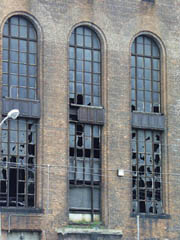The Powerhouse, gutted and empty, is one of Jersey City’s oldest structures. Until recently, it also was one of the city’s lesser concerns. But recently there has been a surge of interest in the old building. In the early 1900s, the Hudson & Manhattan Railroad serviced Hudson County commuters as first and only train system to burrow under the Hudson River. When the trains were introduced to New York and Hudson, they were powered by a massive coal-burning system located above and outside of the rails. At the same time as it was providing power to the railroads, the Powerhouse was also one of the world’s largest office complexes. When the Port Authority bought the Hudson & Manhattan Railroad in the 1960s and turned it into the high-tech PATH system that snakes under the river today, the Powerhouse was no longer needed. Over the years the building has decayed and withered with age, but the steel and brick structure remains intact. Last week, Preservation New Jersey, a non-profit organization based in Trenton, held a press conference at the Barrow Mansion, 83 Wayne St., at which it announced that the Hudson & Manhattan Railroad Powerhouse has been nominated to be included on Preservation New Jersey’s top ten list of endangered historic sites. The designation would come this fall. If designated as a historic site, the Powerhouse would be eligible for numerous preservation grants that would be used to start repairing the building and protecting it from falling to the hands of destruction or neglect. John Gomez, chairman of the Jersey City Landmarks Conservancy said that if the building makes the endangered list, the roof can be fixed with grant funds. Preservation New Jersey, founded in 1978, is the only statewide private membership-supported historic preservation group in the state. Its mission is to protect and promote the state’s historical resources, communities and landscapes through education and advocacy. The building’s split ownership is made up of the Port Authority and the city of Jersey City. Making things even more complicated for preservationists is that the north side is owned by the transportation agency, and the south end is owned by the city. Those that are trying to restore the building said that the dual ownership makes bringing everyone together to talk about the future of the facility that much harder. One such organization is the Jersey City Landmarks Conservancy, who has nominated the Powerhouse to be included on Preservation New Jersey’s endangered list. If left off of the list, some historical preservationists say that the building could be in grave danger of eventually falling apart. But with a historical significance that includes President Theodore Roosevelt taking part in the opening ceremonies of the Hudson & Manhattan railroad, the Landmarks Conservancy is optimistic that the building will be accepted and protected. The Powerhouse has been described as a cathedral of brickwork and steel. The structure is steel-framed and the exterior is made up of 28-inch thick brick walls. The largest windows, among panes of broken shards, are 1,300 square feet each, and on the east side of the building is a sliding door large enough to welcome a railroad car. Above, there is a 200-by-200-foot observation roof that offers unobstructed views to Manhattan and the Hudson River. Other ideas Alternatives for the building include turning it into a museum, convention center, library or even a movie studio. Other ideas have the Powerhouse transformed into a facility much like the Cannery in San Francisco, which is an antique canning warehouse that has been turned into an antique mall and retail house. With close proximity to the WALDO art district, one of Jersey City’s bigger draws, the Powerhouse has also been mentioned as being turned into an art gallery and museum. Other ideas have New Jersey City University taking over the building. No matter what happens to the Powerhouse, advocates for its preservation welcome ideas. “It would be great for the area,” Gomez said. Gomez also said that the climate for this type of project has changed in Jersey City. In the past, he said, historic buildings were neglected and passed over by politicians and residents. “Things here have definitely changed,” Gomez said. “The mayor has made efforts to improve the old Loew’s Theater in Journal Square and they just made improvements to the old Apple Tree House project.” The two projects have been on Mayor Bret Schundler’s top agenda, as is the Powerhouse. For more information about the Powerhouse, visit www.jerseycityhistory.net, a website run by the Landmarks Conservancy and the mayor’s office.
This old Powerhouse: Local group nominates building for state recognition
